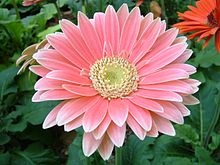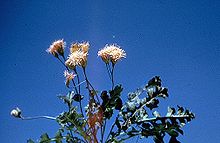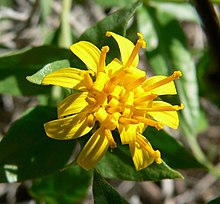Mutisioideae
| Mutisioideae | ||||||||||||
|---|---|---|---|---|---|---|---|---|---|---|---|---|

Gerbera hybrids as potted plants |
||||||||||||
| Systematics | ||||||||||||
|
||||||||||||
| Scientific name | ||||||||||||
| Mutisioideae | ||||||||||||
| ( Cass. ) Lindl. |
The Mutisioideae are a subfamily of the Asteraceae plant family. The distribution is mainly New World ; some species are also found in Africa, Asia and Australia.
The best known are the varieties of gerbera , which today are among the most popular cut flowers worldwide ; recently some varieties have also been offered as indoor plants .
description
There are annual to perennial, herbaceous plants or woody plants: Half bushes to bushes . The mostly alternate and spiral, in basal rosettes or distributed on the stem, rarely arranged opposite leaves are mostly simple. The leaf margin is smooth, serrated to serrated, sometimes prickly.
Only sometimes species are dioeciously separated sexually ( dioecious ), mostly they are monoecious with hermaphrodite or functionally unisexual flowers. The small to large cup-shaped inflorescences are usually singly or rarely in many (hundreds) together in large overall inflorescences . There are rarely only one, mostly a few to many rows of bracts . Chaff leaves are missing.
The ray-flowers are female, with a two-lipped crown; they are seldom missing. In the subfamily of the Mutisioideae, the corolla of the ray-flowers consists of two corolla lips; this is also the case with the subfamily of the Barnadesioideae , but only with the Mutisioideae does one crown lip consist of three and the other of two petals. The disc florets are hermaphroditic or functionally male, with a five-lobed crown; they are radial symmetry to zygomorphic , sometimes a corolla lobe is enlarged. The two scar branches are short. There are five stamens .





Systematics
Synonyms for Mutisioideae (Cass.) Lindl. are: Mutisiaceae Burnett , Nassauviaceae Burmeister , Perdiciaceae Link . The subfamily of the Mutisioideae used to be much more extensive and also contained the genera of the new subfamilies: Barnadesioideae , Gochnatioideae , Hecastocleidoideae , Pertyoideae , Gymnarrhenoideae , Stifftioideae and Wunderlichioideae .
The subfamily of the Mutisioideae is now divided into only three tribes with about 44 genera and about 630 species:
- Tribe Mutisieae Cass. : In addition to the taxa in the New World, there are also species that are native to Asia, Africa and Australia. This tribe used to have a slightly larger size. Today some genera that were previously classified here belong to their own new subfamilies: Gochnatioideae, Hecastocleioideae, Pertyoideae and Gymnarrhenoideae. Today it contains ten to twelve genera:
- Adenocaulon Hook. : The five or so species are common in the New World and eastern Asia.
- Brachyclados Gillies ex D.Don : The only three types are common in South America.
- Chaetanthera Ruiz & Pav .: It is divided into seven subgenera with a total of 43 species. The home is South America.
- Chaptalia Vent. : The approximately 60 species are common in South America.
-
Eriachaenium Sch.Bip. : It contains only one type:
- Eriachaenium magellanicum Sch.Bip. : It is common in southern South America.
- Gerbera L. (including Piloselloides Lessing ): The approximately 35 species are mainly native to Asia and Africa (including Madagascar), only one species occurs in South America.
- Leibnitzia Cass. : The six or so species are found mainly in large parts of Asia, as well as in Mexico and the USA.
-
Lulia Zardini : It contains only one species:
- Lulia nervosa (Less.) Zardini : It is common in Brazil.
- Mutisia Less. : It contains six sections with about 50 species; that occur in South America.
- Pachylaena D. Don ex Hook. & Arn. : The only two species thrive in the Andes of Argentina and Chile.
- Trichocline Cass. : It contains two sections with about 22 species. The home is South America (some authors include Amblysperma spathulata (A.Cunn. Ex DC.) DJNHind , which isnative to western Australia).
- Uechtritzia Freyn : The three or so species are distributed in Asia (from China to Asia Minor: Turkey and Iran).
- Tribus Nassauvieae : It contains about 26 genera:
- Acourtia D.Don : The approximately 65 species are distributed from the southern USA to Central America and on the Caribbean islands.
-
Ameghinoa Speg. : It contains only one type:
- Ameghinoa patagonica Speg. : It only occurs in Patagonia .
- Berylsimpsonia B.L.Turner : The only two species occur only in the Greater Antilles before.
-
Burkartia Crisci : It contains only one species:
- Burkartia lanigera (Hook. & Arn.) Crisci : It only occurs in Patagonia.
-
Calopappus Meyen : It contains only one species:
- Calopappus acerosus Meyen : It thrives in the Andes of Chile.
- Calorezia Panero : The only two species occur in Chile.
-
Cephalopappus Nees & Mart. : It contains only one type:
- Cephalopappus sonchifolius Nees & Mart. : It occurs in northeastern Brazil.
-
Criscia L.Katinas : It contains only one species:
- Criscia stricta (Spreng.) L.Katinas : It is common in Brazil.
-
Dolichlasium Lag . : It contains only one species:
- Dolichlasium lagascae Gillies ex D.Don : It thrives in the Andes of Argentina.
- Holocheilus Cass. : The roughly six species are common in Brazil, Paraguay, Uruguay and Argentina.
- Jungia L. f. : The approximately 26 species are widespread from Mexico to the Andes.
- Leucheria Lag . : The 46 or so species arewidespreadin the Andes in Chile, Patagonia and the Falkland Islands .
-
Leunisia Phil .: It contains only one species:
- Leunisia laeta Phil . : It occurs in central Chile.
- Lophopappus Rusby : The six or so species thrive in the Andes.
-
Macrachaenium Hook. f. : It contains only one type:
- Macrachaenium gracile Hook. f. : It thrives in the Andes of South America in forests with Nothofagus species.
-
Marticorenia Crisci : It contains only one species:
- Marticorenia foliosa (Phil.) Crisci : It occurs in Chile.
- Moscharia Ruiz & Pav .: The only two species occur in Chile.
- Nassauvia Comm. ex Juss. : The approximately 51 species are distributed from the southern Andes to Patagonia.
-
Oxyphyllum Phil .: It contains only one species:
- Oxyphyllum ulicinum Phil . : It is endemic to the Atacama Desert .
- Panphalea Lag .: The six or so species are widespread in South America.
- Perezia Lag .: The approximately 32 species are widespread in the Andes from Colombia to southern Patagonia and in southern Brazil, Uruguay, Paraguay and northeastern Argentina.
-
Pleocarphus D.Don : It contains only one species:
- Pleocarphus revolutus D.Don : It thrives at altitudes of up to 3000 meters in the Chilean regions of Coquimbo and Atacama.
- Polyachyrus Lag. (Syn .: Diaphoranthus Meyen , Bridgesia Hook. , Cephaloseris Poepp. Ex Rchb. ): The approximately six species are common in South America.
- Proustia Lag .: The only two species are distributed today in large parts of the Neotropic, but previously had a somewhat smaller distribution area in the southern half of South America.
- Triptilion Ruiz & Pav .: The seven or so species are common in South America.
- Trixis P.Browne (Syn .: Prionanthes Closet , Bowmania Gardner , Cleanthes D.Don , Bowmannia Gardner , Tenorea Colla , Castra Vell. ): The approximately 34 to 50 species are widespread in the Neotropic.
- Tribus Onoserideae (Bentham) Panero & VAFunk : It contains about six genera:
- Aphyllocladus Wedd. (Syn .: Jobaphes Phil. ): The five or so species are common in South America.
-
Gypothamnium Phil .: It contains only one species:
- Gypothamnium pinifolium Phil . : It is endemic to the Atacama Desert .
- Lycoseris Cass. (Syn .: Diazeuxis D.Don , Langsdorfia Willd. Ex Less. ): The nine or so species occur in the Neotropic.
- Onoseris Willd. (Syn .: Cladoseris (Less.) Spach , Chaetachlaena D.Don , Seris Willd. , Pereziopsis Coult. , Cursonia Nutt. , Onoseris sect. Cladoseris Less. , Hipposeris Cass. , Hilairia DC. , Schaetzellia Klotzsch , Rhodoseris Turcz. , isotype Kunth , Cataleuca K.Koch & Fintelm. , Centroclinium D.Don , Pereziopsis J.M.Coult. , Caloseris Benth. ): the approximately 18 species are now spread throughout much of the Neotropics, but had formerly a slightly smaller distribution area in the southern half South America.
- Plazia Ruiz & Pav .: The three or so species are common in the southern Andes and Argentina.
-
Urmenetea Phil .: It contains only one species:
- Urmenetea atacamensis Phil .: It occurs only in northern Chile and northwestern Argentina.
swell
- The subfamily as part of the Asteraceae family on the AP website. (Sections Description and Systematics)
- Jose L. Panero: Entry in the Tree of Life project, 2008. (Systematics section)
- Jose L. Panero, Vicki A. Funk: New Infrafamilial taxa in Asteraceae. In: Phytologia , Volume 89, Issue 3, 2007, pp. 356-360: full text. (PDF; 29 kB)
- Jose L. Panero, Vicki A. Funk: The value of sampling anomalous taxa in phylogenetic studies: major clades of the Asteraceae revealed. In: Molecular Phylogenetics and Evolution , Volume 47, 2008, pp. 757-782.
Individual evidence
- ^ Entry in the Flora of North America , Volume 19. (Eng.)
- ↑ Database entry in Global Compositae Checklist .
- ↑ a b c d e f g h i j k l m n o p q r s t u v w x y David John Mabberley: Mabberley's Plant-Book. A portable dictionary of plants, their classification and uses. 3. Edition. Cambridge University Press, 2008, ISBN 978-0-521-82071-4 ( limited preview in Google Book Search).
- ↑ a b Federico Luebert, Jun Wen, & Michael O. Dillon: Systematic placement and biogeographical relationships of the monotypic genera Gypothamnium and Oxyphyllum (Asteraceae: Mutisioideae) from the Atacama Desert , in Botanical Journal of the Linnean Society , Volume 159, 2008, Pp. 32-51. Full text. (PDF file; 659 kB)
